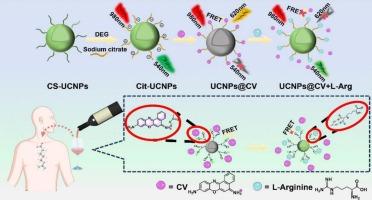基于竞争效应的比例上转换发光纳米探针用于红酒中l -精氨酸的精确监测。
IF 4.6
2区 化学
Q1 SPECTROSCOPY
Spectrochimica Acta Part A: Molecular and Biomolecular Spectroscopy
Pub Date : 2025-10-05
DOI:10.1016/j.saa.2025.127026
引用次数: 0
摘要
l -精氨酸(L-Arg)是一种具有多种生理功能的条件必需氨基酸,也是控制红酒品质的关键因素。然而,由于红葡萄酒中含有多种氨基酸,因此对l -精氨酸的选择性检测仍然是一个挑战。因此,开发高选择性的l -精氨酸定量检测方法对红酒质量控制至关重要。本文通过静电相互作用将甲酰基紫(CV)组装到柠檬酸盐功能化的上转换纳米粒子(Cit-UCNPs)表面,形成UCNPs@CV,设计了一种比例型l -精氨酸上转换发光纳米探针。其中,UCNPs和CV分别作为能量供体和受体。在980 nm激发下,发生了发光共振能量转移(LRET),在540 nm处淬灭UCNPs发射,在620 nm处激活CV发射。在L-Arg存在的情况下,Cit- ucnps表面的CV可以通过L-Arg的胍基与Cit的羧基之间的特异性相互作用而被L-Arg置换,从而中断LRET。结果表明,UCNPs在540 nm处的发射被恢复,CV在620 nm处的发射被减弱。I540/I620与L-Arg浓度呈良好的线性关系,具有较高的选择性和灵敏度,检出限(LOD)为0.079 μM (S/N= 3)。更重要的是,该纳米探针可以成功检测不同类型红酒中的l -精氨酸,在红酒质量控制领域具有潜在的应用前景。本文章由计算机程序翻译,如有差异,请以英文原文为准。

Engineering of a ratiometric upconversion luminescence nanoprobe based on competition effect for precisely monitoring L-arginine in red wines
L-arginine (L-Arg) is a conditionally essential amino acid with multiple physiological functions, and also serves as a key factor in the quality control of red wine. However, selective detection of L-Arg in red wine still remains challenge due to red wine containing a variety of amino acids. Therefore, developing methods with high selectivity for L-Arg quantitative detection is crucial for red wine quality control. Herein, a ratiometric L-Arg upconversion luminescence nanoprobe was designed by assembling cresyl violet (CV) onto the surface of citrate-functionalized upconversion nanoparticles (Cit-UCNPs) through electrostatic interaction to form UCNPs@CV. In which, the UCNPs and CV was employed as energy donor and acceptor, respectively. Under 980 nm excitation, luminescence resonance energy transfer (LRET) occurred, quenching the UCNPs emission at 540 nm and activating the CV emission at 620 nm. In the presence of L-Arg, CV on the surface of Cit-UCNPs could be displaced by L-Arg via the specific interaction between the guanidine group of L-Arg and the carboxyl group of Cit, which interrupted the LRET. As a result, the emission of UCNPs at 540 nm was recovered, and the emission of CV at 620 nm was weakened. Moreover, the ratio of I540/I620 exhibited a good linear relationship with L-Arg concentration, and allowing for high selectively and sensitively detecting L-Arg with a limit of detection (LOD) 0.079 μM (S/N= 3). More importantly, the proposed nanoprobe could successfully detect L-Arg in different types of red wines, holding potential application in the field of red wine quality control.
求助全文
通过发布文献求助,成功后即可免费获取论文全文。
去求助
来源期刊
CiteScore
8.40
自引率
11.40%
发文量
1364
审稿时长
40 days
期刊介绍:
Spectrochimica Acta, Part A: Molecular and Biomolecular Spectroscopy (SAA) is an interdisciplinary journal which spans from basic to applied aspects of optical spectroscopy in chemistry, medicine, biology, and materials science.
The journal publishes original scientific papers that feature high-quality spectroscopic data and analysis. From the broad range of optical spectroscopies, the emphasis is on electronic, vibrational or rotational spectra of molecules, rather than on spectroscopy based on magnetic moments.
Criteria for publication in SAA are novelty, uniqueness, and outstanding quality. Routine applications of spectroscopic techniques and computational methods are not appropriate.
Topics of particular interest of Spectrochimica Acta Part A include, but are not limited to:
Spectroscopy and dynamics of bioanalytical, biomedical, environmental, and atmospheric sciences,
Novel experimental techniques or instrumentation for molecular spectroscopy,
Novel theoretical and computational methods,
Novel applications in photochemistry and photobiology,
Novel interpretational approaches as well as advances in data analysis based on electronic or vibrational spectroscopy.

 求助内容:
求助内容: 应助结果提醒方式:
应助结果提醒方式:


